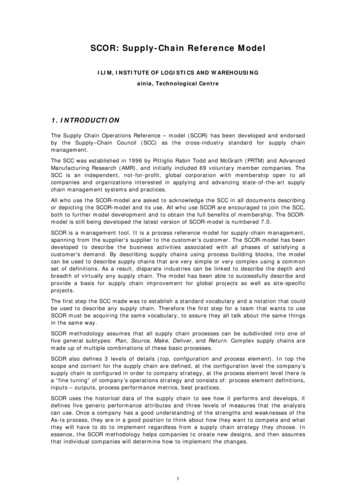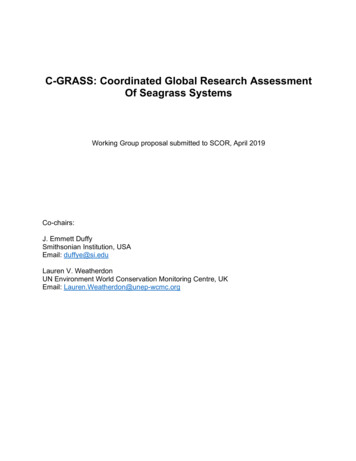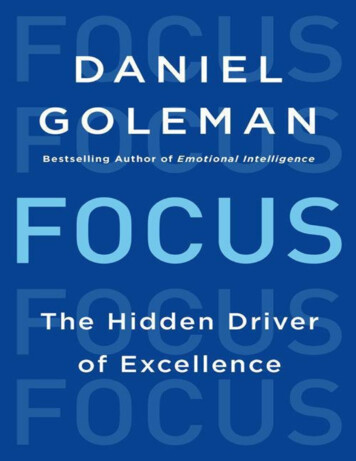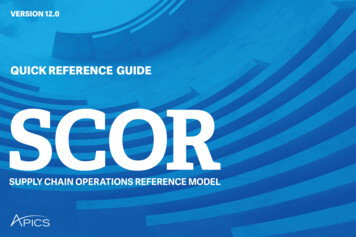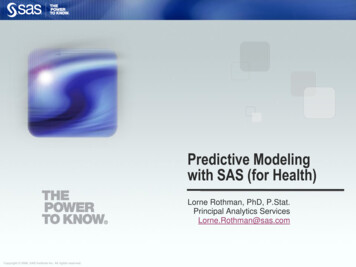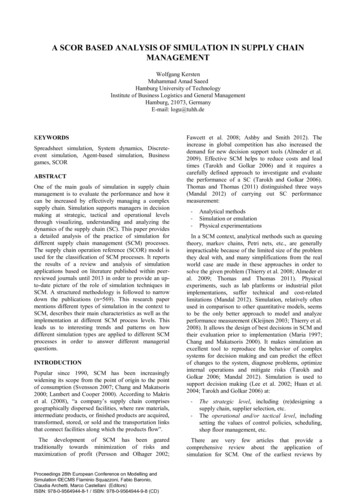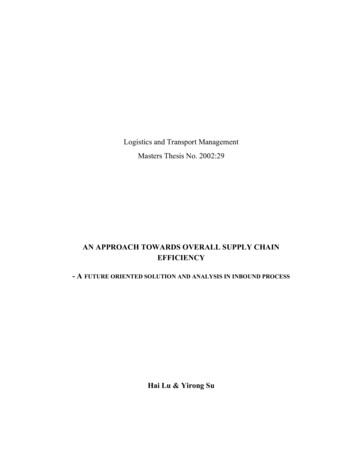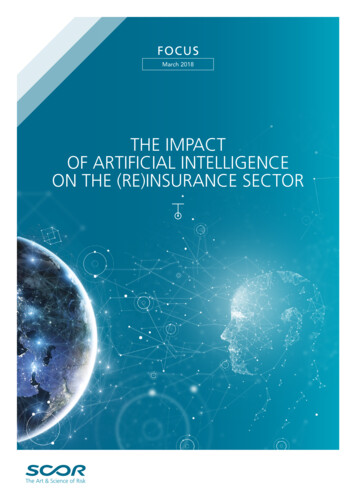
Transcription
FOCUSMarch 2018THE IMPACTOF ARTIFICIAL INTELLIGENCEON THE (RE)INSURANCE SECTOR
The views and statements expressed in this publication are the sole responsibility of the authors.2SCOR - MARCH 2018
CONTENTS6HOW ARTIFICIAL INTELLIGENCE WILLIMPACT THE (RE)INSURANCE INDUSTRYDenis Kessler, Chairman & CEO, SCOR11COMPETING IN THE AGE OF ARTIFICIAL INTELLIGENCE:CURRENT STATE OF AI& INTERPRETATION OF COMPLEX DATANicolas Miailhe, Co-founder and President of The Future Societyat Harvard Kennedy School15RISK MANAGEMENT IMPLICATIONS AND APPLICATIONSOF ARTIFICIAL INTELLIGENCEWITHIN THE (RE)INSURANCE INDUSTRYJennifer Coleman, Senior Risk Manager, SCOR24HOW ARTIFICIAL INTELLIGENCE AFFECTS/HELPSTHE INDUSTRY AND THE (RE)INSURANCE INDUSTRYRound tableWill Thorne, Innovation leader, The Channel SyndicateCécile Wendling, Head of Foresight, AXARichard Hartley, Co-Founder and CEO, CytoraRichard De Sousa, Managing Director for Europe and the Americas, ReMarkInternational30TRANSHUMANISM:THE FUTURE IMPACT OF ADVANCED TECHNOLOGIESON SOCIETY AND ON THE INSURANCE INDUSTRYLaurent Alexandre, CEO of DNA VisionThis publication follows the SCOR Annual Conference that was held in Paris on September 28 and 29, 2017SCOR - MARCH 20183
4SCOR - MARCH 2018
LOOKING FORWARD, THE IMPACT OF ARTIFICIAL INTELLIGENCEINTRODUCTIONLOOKING FORWARD: THE IMPACTOF ARTIFICIAL INTELLIGENCEFor the past few years, Artificial Intelligence (AI) hasbeen rolled out with spectacular speed in an increasingnumber of areas, such as medicine, the auto industry,finance, manufacturing, agriculture and marketing.This expansion lies at the crossroads of three majortechnological developments: the emergence of big data, thenormalization of the interconnection between humans andmachines, and advances in machine learning (technologythat enables machines to learn from experience).AI is progressively transforming the way in which theeconomy and society operate.The insurance industry is concerned by these changes ontwo fronts. Firstly, new risks associated with AI must beassessed, quantified, insured and mitigated against. Theincreasing use of AI raises numerous risk questions. Forexample, in an accident caused by an autonomous vehicle,who is liable – the user, the manufacturer or the creator ofthe algorithm behind the technology? What would be theinsurance consequences of an AI bug or AI cyber-attack?Or, how can the insurer manage the shift in its risk profiledue to impact of AI on biometric, property, casualty,financial, operational and strategic risks. Secondly, howcan the insurance industry leverage off the potential of AI?For example, how can it be used to improve competitiveness,improve customer experience, reduce risk exposures andimprove profits through greater use of automation,efficiency, refined underwriting and segmented pricing?With this in mind, SCOR is committed to incorporatingnew technology into its business and devoted a series ofpresentations and discussions to the topic of AI during itsAnnual Conference 2017.This publication brings together all of these presentationsand also includes a new, specially written article on the riskmanagement implications and applications of AI. DenisKessler, Chairman and CEO of SCOR, talks about the insuranceindustry against the backdrop of AI – what are the challengesinvolved in this historic turning point? Nicolas Miailhe,Co-founder and President of The Future Society at HarvardKennedy School, gives a broad outline of AI, looking at whatit can do, but also, beyond all the fantasy, what it cannot(yet?) do. Jennifer Coleman, Senior Risk Manager at SCOR,provides an analysis of the Risk Management applicationsand challenges of AI for (re)insurance companies. The roundtable moderated by Will Thorne, Innovation Leader forthe Channel Syndicate, queries the changes underway inthe sector: what is changing for insurance companies, andhow can they best incorporate these new opportunitiesinto their strategies? To conclude, Laurent Alexandre, CEOof DNA Vision, gives an impartial view of a developmentthat is impacting society as a whole. In his view, what needsto change is not insurance, but insurers.SCOR - MARCH 20185
HOW AI WILL IMPACT THE (RE)INSURANCE INDUSTRYHOW ARTIFICIAL INTELLIGENCEWILL IMPACT THE (RE)INSURANCEINDUSTRYDenis Kessler, a French citizen, is a graduate of HEC business school(Ecole des Hautes Etudes Commerciales), holds a PhD in economicsand advanced degrees in economics and social sciences, and is a Fellowof the French Institute of Actuaries.DENIS KESSLERChairman & CEO, SCORHe was Chairman of the Fédération Française des Sociétés d’Assurance(FFSA), Senior Executive Vice-President and member of the ExecutiveCommittee of the AXA Group and Executive Vice-President of MEDEF(Mouvement des Entreprises de France). He joined SCOR as Chairmanand Chief Executive Officer on 4 November 2002. In January 2016,he was elected to join the Academy of Moral and Political Sciencesof the Institut de France.ARTIFICIAL INTELLIGENCE: A BURGEONINGFIELD OF RESEARCH WHICH HAS TAKEN USINTO A NEW MACHINE AGENew machines have arrived on the scene. The first machineage, known as the Industrial Revolution, resulted in theautomation of physical labor. The machine age that wehave now entered – the Digital Revolution – will further theautomation of physical labor and drive the computerizationof cognitive tasks through the rise of Artificial Intelligence(AI), i.e., “intelligence” exhibited by machines.ARTIFICIAL INTELLIGENCE IS THESCIENCE OF MAKING MACHINESDO THINGS THAT WOULDREQUIRE INTELLIGENCE IF DONEBY MENMARVIN MINSKYLeader in AI research in the 1950sFROM FICTION TO REALITYThe concept of “intelligent” artificial beings is not new.Since the 19th century, history and literature have providedfantastical approaches to AI. The most striking exampleis Mary Shelley’s creation of Frankenstein’s monster twohundred years ago. The idea of this creature, incidentally,6SCOR - MARCH 2018In 1950, Alan Turing developed his famous AI test,which aims to measure the ability of a machine toexhibit behavior that is indistinguishable from thatof a human.The Turing test separates a human interrogatorfrom two respondents – a computer and ahuman. If the interrogator is unable to tell whois responding, the machine is considered to be asuccessful AI tool.
HOW AI WILL IMPACT THE (RE)INSURANCE INDUSTRYcame about during the gloom created by the 1815 volcaniceruption of Mount Tambora in Indonesia, which led toaround three years of global climate upheaval, disruptingthe rhythm of the seasons and disturbing temperaturesand rainfall, causing famine, epidemics and social disorder.The field of AI research was developed in the 1950sby pioneers such as Herbert Simon, Allen Newell, JohnMcCarthy, Marvin Minsky and Arthur Samuel. All wereoptimistic about the future of AI, and had concludedthat within twenty years, machines would be capable ofaccomplishing any human task. Minksy claimed that, “withinthe next generation, the problem of creating ‘artificialintelligence’ would substantially be solved.” In hindsight,they failed to identify significant obstacles that lay on thepath to achieving this goal.In the years that followed, the field of AI went throughseveral cycles, with periods of disappointment, criticismand funding cuts (called AI winters) alternating with briefperiods of renewed interest.THE COMEBACKMachinelearningKnowledgerepresentationDeep learningVisualizationNatural languageprocessingVirtual personalassistantsDeep Q&AsystemsSocial networkanalysisNatural systemsSensors/internetof thingsSoft analyticsAudio/speechanalyticsAs we all bear witness today, the field of AI has maderemarkable progress in the last 20 years, driven by acombination of factors: exponential growth in computing power and memorycapacity; the development of cloud computing and distributed andparallel processing;FIGURE 1: GLIMPSE OF THE MAIN RESEARCH FIELDS ENCOMPASSED BY AISource: PwC report “AI in Insurance: Hype or Reality?”, March 2016 and, last but not least, significant improvements in theoretical understanding.Machine learning, which can be defined as the science andengineering of making machines “learn”, is at the heartof AI. These processes have already become ubiquitous indaily life, from search engines to virtual assistants and roboadvisors, and leave many to wonder where this burgeoningfield of research could lead.Since the 1950s, the field of AI has evolved to cover anextensive range of concepts, including cognitive computing,natural language processing, robotics, image analytics,sensors and numerous areas of research.The AI revolution is a priority topic for decision makers,governments and private industries given the economic,geopolitical, social and business consequences it may havein the years to come. the availability of large databases (to “train” algorithms); global connectivity of both humans and machines;WHY AI IS A GAME CHANGER FOR (RE)INSURANCEThe development of AI will have a threefold impact on the(re)insurance industry.RETHINKING THE BASICS OF INSURANCEHistorically, the parties to an insurance contract – theinsurer and the insured – have always had a different setof information. This is fundamental to understandinginsurance economics, because asymmetry leads to strategicbehaviors. The insurer will attempt to extract the maximumamount of data through questionnaires, observations andstatistics, so as to infer how the insured will behave. Theinsured, for his or her part, may endeavor through strategicpositioning to underestimate the risk, to maximize the valueof the claim and to manipulate the price system to his orher advantage. As such, this information asymmetry leadsdirectly to adverse selection and moral hazard, both ofwhich are fundamental concepts in insurance economics.SCOR - MARCH 20187
HOW AI WILL IMPACT THE (RE)INSURANCE INDUSTRYDevelopments in AI and data collection stand to completelyalter this asymmetry by bringing comprehensive anddynamic observability to the insurance transaction. Whereasinformation was previously incomplete, static, fragmentaryand delayed, the new era of big data enables access toinformation that is comprehensive, accessible from multiplesources, ranked by quality and available on a real-timebasis. Furthermore, the formerly high costs of obtaininginformation have been reduced to a minimal expense.Information is becoming a commodity, and AI will enableus to process all of it.By redefining the concepts that have always beenpart of the insurance industry, AI will constitutea quantum leap for the sector.AI and data will take us into a world of ex-ante predictabilityand ex-post monitoring, which will change the way risks areobserved, carried, realized and settled. This fundamentalchange will lead to profound changes to market balancesand equilibriums in the (re)insurance sector, and willcompletely redefine the dynamics of the insurance market,on both the supply and the demand side.Although (re)insurers might have an early advantage giventhat they have greater means and more tools and, for thetime being, more data, AI will transform both sides of theinsurance transaction in the long run. All parties to theinsurance ecosystem, be they risk carriers, brokers, or evencustomers, will use AI tools. It is even likely that negotiationsand discussions could take place between the AI systems ofthe different parties to the insurance contract! This mightappear futuristic, but the idea of two AI systems duelingwith each other and trying to “fool” each other alreadyunderpins generative adversarial networks (GAN) and theconcept of adverse learning, which are used in research forvideo recognition and analysis.REDEFINING THE DISTRIBUTIONOF INSURANCE PRODUCTS ANDSERVICES, STRONGLY ENHANCINGEFFICIENCIES IN UNDERWRITING ANDCLAIMS PROCESSING, REFINING OURKNOWLEDGE AND MODELING OFRISKS, AND EVEN FOSTERING PRODUCTDEVELOPMENT AND INNOVATIONAs AI stands to be integrated into nearly every part of theinsurance ecosystem, from customer experience to productinnovation, it will drive other significant changes for the(re)insurance industry, notably in the way that it deliversits products and services.The main developments are summarized in the table.In short, AI will enable the (re)insurance industry to bothimprove the customer experience and to enhance efficienciesin underwriting, claims processing, risk analysis and productdevelopment. Tasks that once took months to finish can becompleted in a matter of minutes, opening the gate forinsurers to reap sizable cost savings. Further, in enabling(re) insurance professionals to focus on value-added tasksand by alleviating administrative and process-relatedburdens, AI will augment (re)insurers’ capabilities to analyzerisk and design new products.As a result, (re)insurers will know their customers and risksmore thoroughly, price and underwrite more accurately,better identify fraudulent claims, and detect and monitorevolving risks. They will be able to tailor products andservices to the exact needs of their customers, when andas those needs appear and evolve.PROCESS AREAS THROUGHWHAT’S IN THE PIPELINE?Redefining the valuepropositionPersonnalized customer experienceExploiting social data to predict customers’ needs and behaviors,and personalizing interactions and tailoring offersRedefining the distribution ofproducts and servicesDigital financial adviceAnalyzing household balance sheets and income statements torecommend, monitor and alter financial goals and portfolios for customersEnhancing efficiencyin underwritingAugmented and automated underwritingAutomating underwriting, whilst highlighting key considerations forhuman decision-makersEnhancing efficiency in claimsprocessingRobo-claims analyzers and adjustersAutomating claims analysis, insight and settlement as well as frauddetection and complaint responseImproving product innovationEmerging risks and trends detection systems"Man Machine Learning" i.e. combining human creativity with automatedanalysis and synthesis of large volumes of dataTABLE 1: ENHANCING (RE)INSURANCE OPERATIONS THANKS TO AIMain source: PwC report “AI in Insurance: Hyper or Reality?”, March 20168SCOR - MARCH 2018
HOW AI WILL IMPACT THE (RE)INSURANCE INDUSTRYTRANSFORMING OUR RISK UNIVERSEThrough the creation of more rigorous and systematicdetection systems for fraud, errors and risks, AI can solvemany of today’s challenges in the risk universe. However, tothink that AI will eliminate risk entirely is a fallacy. Like alltechnological developments, it also creates new “intrinsic”risks, which could potentially be very significant.As an example, if AI software were to be poorly programmedor if a bug were to be introduced, the resulting output couldlead to the making of an extremely suboptimal decision.Cyber-risk – whether unintentional (e.g., program error orbug) or intentional (malicious cyber-attacks) – will becomeincreasingly more significant as AI technology becomeswidely adapted.1Reducing information asymmetryand bringing comprehensive anddynamic observability in theinsurance transaction2Improving efficiencies andinsurance product innovationHOW ARTIFICIALINTELLIGENCE WILL IMPACTTHE (RE)INSURANCEINDUSTRY3Creating new“intrinsic“ AI risksFIGURE 1: THE IMPACT OF AI ON THE (RE)INSURANCE INDUSTRYWILL BE THREEFOLDSource: SCORCOPING WITH THE DISRUPTION CAUSED BY AI REQUIRESTIMELY ADAPTATION THROUGH INTEGRATION ANDTRAININGProvided that its integration is well-designed and correctlyexecuted, AI will be an overall positive development forthe (re)insurance industry. Most notably, it will contributeto bridging the protection gap, enhancing risk knowledge,offering a better and more granular match between risk andthe price of risk, improving efficiencies, pushing the frontiersof insurability and fostering prevention and precaution.Enjoying the full benefits of AI requires (re)insurersto embrace this new technology and to regard it as aremarkable opportunity – the openness to change shouldrun deep within companies.THE RELEVANT ATTITUDE FOR (RE)INSURERSIS TO INTEGRATE AI RAPIDLYPotentially disruptive technologies should not be feared;they should be invested in and adopted. This means that thefirst step for (re)insurers is to fight the risk-adverse cultureof the industry, which has not historically been viewed asan early adopter of new technologies. “Think big, startsmall”: the transformation of the industry will follow anevolutionary path. Experimenting and (potentially) failingare part of the process.(Re)insurers have to therefore embrace and incorporate thedigital revolution rapidly within their processes and businessmodels. They will have to invest individually, but collectiveinvestment in tools and technologies shared by marketparticipants will also be necessary, because connectivity iskey. Standards must be set to ensure that the AI tools ofthe (re)insurance industry all speak a common language,which can only be driven by industry-wide projects. Onthis matter, SCOR is proud to be an active member of B3i,the Blockchain Insurance Industry Initiative, which lays thegroundwork for platforms to develop AI tools.Insurance, like any other economic sector, is an industry inwhich constant innovation and adaptation are necessaryto maintain a competitive position. The more (re)insurersintegrate AI, the less contestable they will be.(RE)INSURANCE PROFESSIONALS WILLNEED TO LEARN TO COOPERATE ANDCOLLABORATE WITH AIAI will inevitably affect the way (re)insurance professionalsare recruited and trained, and how they perform their duties.Tomorrow is not about men or machines: it is about menand machines working together. Technology is an enabler.To avoid the perception that AI is in direct competition withhuman capital, proximity between employees and AI mustbe established. Training should be put in place so that peopleunderstand the basics of the underlying technology andwhat happens inside the “black box”. Therefore a shift – or,to be more precise, a complement – to the skillset of thosewho work in the sector will be necessary. Analytical skills willneed to be supplemented by software development skills,and actuarial science by data and AI science.SCOR - MARCH 20189
HOW AI WILL IMPACT THE (RE)INSURANCE INDUSTRYWHERE SCIENCE ENDS AND ART BEGINSThe idea that virtually all human labor will eventually bereplaced by low-cost, highly efficient AI has gained traction.I do not believe in this fantasy.There are three distinctly human elements that arefundamental to value creation: Judgment: integrating soft considerations on top oftechnical and analytical considerations; Innovation, creativity and heuristics: imagining anddesigning new systems and modes of operation; Accountability: being a decision-maker capable ofexplaining and sharing views, while also taking responsibilityfor actions and their consequences.AI will not replace our usefulness; on the contrary, it willenable us to focus our thinking and efforts on value-addedtasks.We should never forget that risk management, which liesat the heart of our industry, is both a science and an art.Reinsurance is firstly based on science – the understandingand modeling of risk. But while analytical considerationsare highly important, they only account for one part ofthe equation. The scientific aspect of our professionmust always be complemented by an artistic or artisanalapproach. Relationships that foster trust on both sides ofthe transaction take time to develop, and the experiencedunderwriter’s ability to follow his instincts has not been – asof yet – put into an equation.10SCOR - MARCH 2018The combination of theoretical and analytical considerationson the one hand, and empirical and instinctive considerationson the other, make reinsurance one of the most fascinatingindustries. It is no coincidence that SCOR’s tagline is “TheArt and Science of Risk.” You need both, because alchemyis as important as chemistry. From that perspective, I amconvinced that the human touch that resides in our businessis irreplaceable by AI.Denis Kessler Chairman & CEO, SCOR
COMPETING IN THE AGE OF ARTIFICIAL INTELLIGENCECOMPETING IN THE AGE OFARTIFICIAL INTELLIGENCE:THE STATE-OF-THE-ART OF AI &INTERPRETATION OF COMPLEX DATANICOLAS MIAILHENicolas Miailhe, Co-founder and President of The Future Society1 atHarvard Kennedy School, has highlighted key issues linked to therise of AI and its capacity to disrupt the insurance sector. Artificialintelligence is a powerful tool that will help to improve risk profiling.However, this process in itself creates new risks.Co-founder and President of The FutureSociety at Harvard Kennedy SchoolTHE COLLECTIVE IMAGINATION OF AIThe notion of AI has always been highly contested.In many ways, a collective imagination subsists and the fieldsuffers from a sort of mystification. The general opinionconcerning the rise of AI is that it will existentially transformour very nature as human beings. This debate stems from,and is often contaminated by, the lack of articulationbetween the existential and more menial, day-to-day,business-related questions concerning the impact of the riseof AI. Qualifying AI correctly helps to dispel the mystificationthat surrounds it.WHAT IS ARTIFICIAL INTELLIGENCE ?AI encompasses all intelligent “agents” (computer systems)that have the capacity to learn, adapt and successfullyoperate in dynamic and uncertain environments. They aremostly immaterial, or machines without motor functions.The field of AI lies at the intersection of three mega-trends:big data, cloud supercomputing and machine learning. Manyscientists and engineers claim there is another convergence- between AI and neuroscience - by asserting that artificialneural networks emulate the brain.1. The Future Society, a think tank incubated at the Kennedy Harvard School of Governmentin Boston, specializes in impact issues in the governance of emerging technologies. Theirgoal is to open up the discussion on the rise of AI and other emerging technologies such asneurotechnologies and biotechnologies. Join the discussion at www.aicivicdebate.org (a globalparticipatory debate on AI governance in 5 languages)Metaphorically, and in terms of certain concepts such asdeep neural networks, we are borrowing from the brain.However, the convergence between the fields of statistics,information technology and neuroscience is largelyoverestimated.Nevertheless, this convergence could potentially occurin the next ten to twenty years, through the developmentof knowledge about the brain and the deep bio-chemicalprocesses that are involved in its make-up.Big Data(incl. ng(e.g Deep Learning)FIGURE 2: AI SITS AT THE INTERSECTION OF THREE MEGA-TRENDSSource: Nicolas MiailheSCOR - MARCH 201811
COMPETING IN THE AGE OF ARTIFICIAL INTELLIGENCEOnce that knowledge and understanding have beenacquired, they can be applied to AI. With this newconvergence, a number of new questions will arise, such asautomation, delegation of power and tensions betweenvalues.THE KEY ROLE OF DEEP LEARNINGNo neural network can exist without “Big Data”, or huge,constantly growing stocks and flows of data, which mustthen be processed. This data is now available and can beprocessed by a growing computing force, scalable on thecloud. This has created a new opportunity; an old branchof computer science theorized in the 1950s, namely machinelearning, is now capable of delivering value.Many disciplines are involved in machine learning, but onestands out in the current revolution: deep machine learning.It relies on complex statistical models and algorithms withmultiple layers of parallel processing that loosely modelthe way a biological brain works. These systems, which runon powerful computers (GPUs), are both self-learning andtrained; we assign a goal to the machine and feed it witha huge amount of data. When deep learning neuralnetworks were theorized in the fifties, they lacked thenecessary computing technology and Big Data to supportthem, and started off with only three or four layers.This capacity has now been extended to hundreds of layersin one system.THE MARCH TOWARDS ARTIFICIALGENERAL INTELLIGENCE (AGI), OR“STRONG AI”A boundary has been set between “weak” or “narrow”Artificial Intelligence (ANI) – the general and currentstandard for AI - and “strong” or “general” ArtificialIntelligence (AGI), which is an AI that would replicate theentire range of lateral cognitive functions that human brainscan deliver. The crossing of that line would result in a majorrevolution, with the potential to disrupt entire industries.However, if the boundary between AGI and ANI is definedthis way, the industry could be creating major blind spots.Current knowledge of the human brain is still incomplete,so the boundary has been built in relation to somethingthat is as of yet not fully understood. Therefore, the currentdefinition of AGI should be reexamined, reconstructedand consolidated in order to respond to the current dynamicsof the rise of ficialIntelligenceAntTime2016 2030? 2050? 2100? NeverFIGURE 3: THE MARCH TOWARDS ARTIFICIAL GENERAL INTELLIGENCESource: Nicolas MiailheWILL THIS GLOBAL AI RACEBECOME THE 4 TH INDUSTRIAL REVOLUTION?Defense and security, techno-scientific advances, globalstrategy competition, competing national interests,the need for solutions for global emerging challengesand many more are both the cause and the acceleratorsof the growth of the AI market. It has accelerated in sucha way that this market is gradually turning into a full-blownrevolution whose disruption is so widespread that it couldwell be the next industrial revolution.THE RISE OF AIThe development of AI has always been driven by a technoscientific revolution propelled by Defense and Security.Its acceleration is due to the global strategy competition12SCOR - MARCH 2018of various national interests and the ensuing arms racewhich is increasingly taking place in the cyber world wherewe are witnessing a convergence between cyber-weaponsand machine learning.The most visible example of convergence took place duringthe “Cyber Grand Challenge” organized in the summer of2016 by DARPA, the US Defense Advanced Research ProjectsAgency. Building upon a well-established tradition of grandchallenges aimed at disrupting entire industries, the agencyselected teams from the best universities in the country.During the competition, each team’s Cyber ReasoningSystem (CRS) automatically identified software flaws,and scanned a purpose-built, air-gapped network to identifyaffected hosts.
COMPETING IN THE AGE OF ARTIFICIAL INTELLIGENCEWhen Facebook and Apple deployed their own strategies,their goals were to maximize their profit. The competitionis bound to deliver productivity gains and thereforeaccelerate the development and deployment of AI tools.Because these tools learn through vast, growing stocks ofdata, they will ultimately respond to a law of concentration.The rise of AI is also at the center of security issues, such as thewar against terrorism. For example, IARPA, the IntelligenceAdvanced Research Projects Activity, is the equivalentof DARPA for the US intelligence community. When theCIA or NSA wants to harness the power of technology tofind solutions to the main issues confronting it, they applyto IARPA. As an example, IARPA is currently leading the“Diva” program to fund the development of deep neuralnetworks capable of delivering a search engine based onvideos using image recognition technology. What is theirobjective? In certain cases, Jihadists train other extremistsaround the world by filming “how to” videos to teach eachother how to build bombs. The video is then uploaded toa platform such as YouTube without being described or“tagged”, and sent by other means to another people whowill be able to retrieve the information and learn from it.Because these videos disseminate extremist propaganda,it is essential that they be located, despite the fact that theyare not labeled as hateful or as having a terrorist content.Image recognition makes this possible and it is this type ofproject that IARPA is actively working on.TOWARDS AN ASYMMETRIC GLOBALOLIGOPOLY?Although it remains a contested field, the AI market isgrowing. Some experts say that it will be worth 40 billiondollars by 2020, while others advance smaller figures.The general consensus remains that the market is on thebrink of a revolution, which will be characterized by anasymmetric global oligopoly.It is global for obvious reasons. The world is interconnected— everyday, we “import” AI from the U.S. to Europe eachtime we perform a web search or language translation,for instance. We can expect the same to happen withregard to China as Alibaba and Tencent start rolling outtheir solutions globally.The market is qualified as oligopolistic because of theassociation between the scale effects and network effectswhich drive concentration. The value of Facebook dependson the network effect, or the fact that our personal networkuses that particular social media. Combined with scale effectsin relation to how data is needed to fuel AI algorithms, thisexplains why there cannot be multiple Facebooks.If the differentiating factors, due to the rise of deep learningnetworks, turn out to be as powerful as they are expectedto be, then a winner-takes-all paradigm can be anticipated,which in turn will accelerate the race. Today, two opposingglobal blocks, GAFA and BATX2, have emerged from the twolargest world markets: the U.S. and China. Smaller countrieswill find it very difficult to stand on their own, because theylack the critical mass market needed to generate substantialand sufficient flows of data. The right scale is probablycontinental, which is why the market is currently dominatedby the US and China.EMERGING GLOBAL CHALLENGESWhile the global ma
change will lead to profound changes to market balances and equilibriums in the (re)insurance sector, and will completely redefine the dynamics of the insurance market, on both the supply and the demand side. Although (re)insurers might have an early advantage given that they have greater means and more tools and, for the
